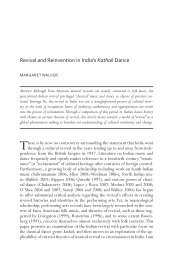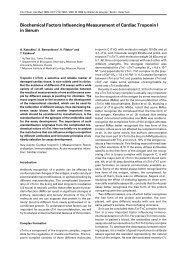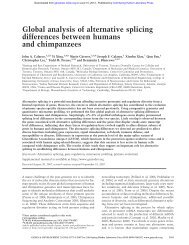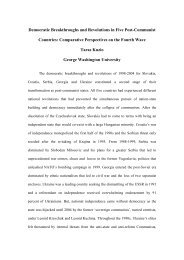April, 2001 THE NEW HUMAN KALLIKREIN GENE FAMILY 185“kininogenases.” <strong>The</strong> term “kininase” is used to describeother enzymes that can inactivate kinins. Among the knownhuman and animal tissue kallikreins, only one enzyme hasthe ability to release efficiently a bioactive kinin from akininogen. In humans, this enzyme is known as pancreatic/renal kallikrein or, with the new nomenclature, as the KLK1gene, encoding for human kallikrein 1 (hK1 protein) (9–12).This enzyme acts upon a liver-derived kininogen (low molwt kininogen) to release lysyl-bradykinin (also known askallidin), which is involved in the control of blood pressure,electrolyte balance, inflammation, and other diverse physiologicalprocesses. <strong>Tissue</strong> kallikrein (hK1) may further enzymaticallydigest other substrates, including growth factors,hormones, and cytokines, to mediate pleiotropic effects(7).It should be emphasized that the generic term “tissuekallikrein” is not restricted to the description of enzymes thatrelease bioactive peptides from precursor molecules. <strong>The</strong>term is used to describe a group of enzymes with highlyconserved gene and protein structure, which also share considerablesequence homology and colocalize in the samechromosomal locus as the KLK1 gene. In this review, theterm “kallikrein” will be used to describe a family of 15 genesthat have a number of striking similarities, as outlined inpoint format in Table 1 (13). <strong>The</strong> use of the term “kallikrein”does not necessarily imply that any of these family members(with the exception of KLK1) have kininogenase activity. Infact, for human family members that have been functionallytested, it was found that they possess very low (hK2) (14, 15)or no kininogenase activity [prostate-specific antigen (PSA)](14). <strong>The</strong>se enzymes are grouped together with KLK1, basedon the similarities outlined in Table 1.II. <strong>The</strong> <strong>Human</strong> and Rodent Families of<strong>Kallikrein</strong> <strong>Gene</strong>s<strong>The</strong> tissue kallikrein literature can be roughly separatedinto various periods as follows. Early in the 1920s and 30s,researchers discovered the basic components of the kallikrein-kininsystem and identified the molecular structure ofbradykinin and kallidin (lysyl-bradykinin) in the 1960s (8).<strong>The</strong> molecular biology of the tissue kallikrein gene familywas worked out in detail in both the human and rodents inthe 1980s (16–19). It was then concluded that the mouse andrat gene families were composed of many genes, clustered inthe same chromosomal locus. In particular, the mouse tissuekallikrein gene family is localized on chromosome 7 andconsists of 24 genes, of which at least 14 encode for activeproteins (the remaining being pseudogenes) (16, 20–22). <strong>The</strong>area on chromosome 7 encompassing the mouse kallikreinsis homologous to an area on human chromosome 19q13.4that harbors the human kallikrein gene family. <strong>The</strong> rat tissuekallikrein gene family is composed of approximately 20 homologousgenes of which at least 10 are expressed (18, 23–30).Most of the rodent tissue kallikreins are expressed in thesalivary glands, but a few, including the prostate, pituitarygland, and endometrium, have more diverse tissue expression(7, 9, 31–33). It is not the purpose of this review todescribe in detail the rodent or other animal tissue kallikreingene families. Excellent reviews on this subject already exist(9, 16, 17, 21, 22).<strong>The</strong> human tissue kallikrein gene family was also discoveredin the 1980s and it was then concluded that the entirefamily is composed of only three genes, namely KLK1, encodingfor pancreatic/renal kallikrein (hK1 protein), theKLK2 gene, encoding for human glandular kallikrein 2(hK2), and the KLK3 gene, encoding for PSA (hK3) (34–38).<strong>The</strong> major interest in human kallikreins lies in the very restrictedtissue expression of hK2 and hK3 in the prostate,which qualifies them as candidate biomarkers for prostaticdiseases (39–43). hK3 (PSA), in particular, has gained prominencein recent years as the most valuable tumor markerever discovered and is currently used widely for the diagnosis,monitoring, and population screening for prostate cancer(44–51). <strong>The</strong> introduction of this test has had a majorimpact on prostate cancer diagnosis and monitoring and thisfield is still evolving (52, 53). More recently, PSA applicationshave extended beyond the prostate, including breast andother cancers (54–57). Over the last few years, human glandularkallikrein 2 is emerging as an additional prostatic andbreast cancer biomarker, and it is now clear that it can supplementPSA testing for improved identification and differentialdiagnosis of prostate cancer (43, 58–66). It is thuslogical to exploit the possible applications of other membersof this gene family for cancer and other disease diagnosis andmonitoring.In the last 3 yr, we have witnessed the emergence of newknowledge related to the human kallikrein gene family (13).Independent researchers have cloned a number of new serineprotease genes that show significant homologies with theclassical human kallikreins; in addition, when these newprotease genes were mapped, they were found to colocalizein the known human kallikrein gene locus on chromosome19q13.3-q13.4 (67–90). <strong>The</strong> recent detailed molecular descriptionof the human kallikrein gene locus (67, 68) enabled usto construct a physical map containing 15 genes that shareTABLE 1. Similarities between members of the new human kallikrein gene family1. All genes localize to the same chromosomal region (19q13.4).2. All genes encode for putative serine proteases with a conserved catalytic triad (histidine, aspartic acid, and serine in the appropriatepositions).3. All genes have five coding exons (some members contain one or more 5-untranslated exons).4. Coding exon sizes are similar or identical.5. Intron phases are fully conserved among all 15 human members and among members of the rodent kallikrein gene families. a6. All genes have significant sequence homologies at the DNA and amino acid levels (40–80%).7. Many of these genes are regulated by steroid hormones.a Intron phase refers to the location of the intron within the codon: intron phase I, the intron occurs after the first nucleotide of the codon;II, the intron occurs after the second nucleotide; 0, the intron occurs between codons.
186 YOUSEF AND DIAMANDIS Vol. 22, No. 2significant structural similarities (Table 1). Some of thesegenes appear to be related to breast, ovarian, and other humancancers, and a few of them appear to encode for functionaltumor suppressor genes. In view of these very recentdevelopments, we will describe, in this review, the knowledgethat has accumulated on these genes, with special emphasison the structure of the genes and proteins, their tissueexpression and hormonal regulation, and their connection tovarious human diseases. Where possible, functional aspectsof these enzymes will also be described. We hope that thesummary of these new findings on the human kallikrein genefamily will facilitate further research toward better understandingtheir physiological function, their pathophysiologyand connection to human diseases, and their possible applicationsin the diagnosis and monitoring of various malignanciesand their future suitability as therapeutic targets.III. NomenclatureUntil 2–3 yr ago, only three human kallikrein genes wererecognized: the pancreatic/renal kallikrein (KLK1), thehuman glandular kallikrein 2 (KLK2), and PSA (KLK3).Rittenhouse and co-workers (43, 49) have recently publishedthe revised nomenclature for these three genes. <strong>New</strong> developmentsled to the identification of 15 different genes exhibitingsignificant homologies and other similarities, as describedin Table 1 (13). Since many of these genes were clonedindependently by different investigators, various empiricalnames were initially used for their description.<strong>The</strong> <strong>Human</strong> Genome Organization (HUGO) has recentlyproposed guidelines for human gene nomenclature. Initially,some members of the new kallikrein gene family were classifiedby HUGO along with other serine proteases under theprefix “PRSS”, standing for “protease serine.” It is now clearthat this designation does not serve well the needs of thefuture since members of this multigene family are classifiedtogether with other serine proteases that map in differentlocations of the genome.<strong>The</strong> construction of the first detailed map of the humankallikrein gene locus (13, 67, 68) allows for a more rationalassignment of official gene symbols. Since the rodent andother animal species kallikrein multigene families wereknown before 1992, an international working party hadreached agreement in 1992 on uniform nomenclature of theanimal kallikreins and the three human kallikreins known atthat time (91). Based on this paradigm and the guidelines ofHUGO (for details please visit the Website: http://www.gene.ucl.ac.uk/nomenclature/), an international group ofscientists working in the field agreed to adopt a nomenclaturefor the newer human kallikreins, consistent with thatalready defined for KLK1–3, as shown in Table 2 (92). In thesame table, we also include previous symbols based onthe PRSS system as well as names originally proposed by thediscoverers of these genes (93–100). <strong>Gene</strong> numbering startsfrom centromere to telomere on chromosome 19q13.4 withthe exception of the three classical kallikreins for which theexisting nomenclature was retained and one newly discoveredgene, which maps between KLK1 and KLK2 genes (69).It is possible that, in the future, new members of this genefamily may be identified, either centromeric to KLK1 ortelomeric to KLK14 (see below). If new kallikrein genes areidentified in this locus, they will be sequentially numbered,starting with KLK16.IV. <strong>The</strong> <strong>Human</strong> <strong>Kallikrein</strong> <strong>Gene</strong> LocusA. Locus organization<strong>The</strong> availability of linear genomic sequences around chromosome19q13.3–q13.4 from the human genome project (thesequences were generated by the Lawrence Livermore NationalLaboratory) allowed the precise localization of the 15members of the new human kallikrein gene family with highaccuracy (1 nucleotide) (68) (Fig. 1). <strong>The</strong> three classicalkallikreins, KLK1, KLK3, and KLK2, cluster together withina 60-kb region, as previously described by Riegman et al. (36,TABLE 2. Proposed new nomenclature for human kallikreins<strong>New</strong> genesymbol a,bPrevious genesymbol(s)<strong>New</strong> proteinsymbolOther protein names/symbolsGenBankaccession no.ReferenceKLK1 KLK1 hK1 Pancreatic/renal kallikrein, hPRK M25629, M33105 34, 93KLK2 KLK2 hK2 <strong>Human</strong> glandular kallikrein 1, hGK-1 M18157 94KLK3 KLK3 hK3 Prostate-specific antigen, PSA X14810, M24543, M27274 95–97KLK4 PRSS17, KLK-L1, hK4 Prostase, KLK-L1 protein, EMSP1 AF113141, AF135023, AF148532 70–72, 79KLK4KLK5 KLK-L2 hK5 KLK-L2 protein; HSCTE AF135028, AF168768 80, 81KLK6 PRSS9 hK6 Zyme, protease M, neurosin AF013988, AF149289, U62801, 73, 74, 82, 83D78203KLK7 PRSS6 hK7 HSCCE L33404, AF166330 84, 85KLK8 PRSS19 hK8 Neuropsin; ovasin; TADG-14 AB009849, AF095743, AB010780, 86, 98AF055982KLK9 KLK-L3 hK9 KLK-L3 protein AF135026 67KLK10 PRSSL1, NES1 hK10 NES1 protein AF055481, NM_002776 76, 99, 87KLK11 PRSS20 hK11 TLSP/hippostasin AB012917, AF164623 88, 89, 100KLK12 KLK-L5 hK12 KLK-L5 protein AF135025 77KLK13 KLK-L4 hK13 KLK-L4 protein AF135024 78KLK14 KLK-L6 hK14 KLK-L6 protein AF161221 90KLK15 hK15 AF242195 69a <strong>The</strong> order of the genes on chromosome 19q13.4 is shown in Fig. 1.b For full gene names, see abbreviation footnote.
















